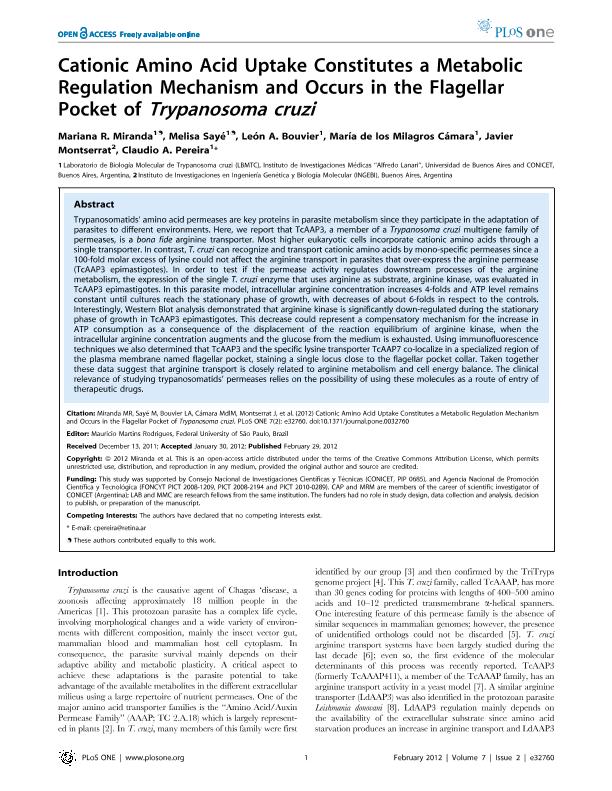Mostrar el registro sencillo del ítem
dc.contributor.author
Miranda, Mariana Reneé

dc.contributor.author
Martínez Sayé, Melisa Soledad

dc.contributor.author
Bouvier, León Alberto

dc.contributor.author
Camara, María de los Milagros

dc.contributor.author
Montserrat, Javier Marcelo

dc.contributor.author
Pereira, Claudio Alejandro

dc.date.available
2019-07-11T18:25:44Z
dc.date.issued
2012-02
dc.identifier.citation
Miranda, Mariana Reneé; Martínez Sayé, Melisa Soledad; Bouvier, León Alberto; Camara, María de los Milagros; Montserrat, Javier Marcelo; et al.; Cationic amino acid uptake constitutes a metabolic regulation mechanism and occurs in the flagellar pocket of trypanosoma cruzi; Public Library of Science; Plos One; 7; 2; 2-2012; 32760-32766
dc.identifier.issn
1932-6203
dc.identifier.uri
http://hdl.handle.net/11336/79370
dc.description.abstract
Trypanosomatids' amino acid permeases are key proteins in parasite metabolism since they participate in the adaptation of parasites to different environments. Here, we report that TcAAP3, a member of a Trypanosoma cruzi multigene family of permeases, is a bona fide arginine transporter. Most higher eukaryotic cells incorporate cationic amino acids through a single transporter. In contrast, T. cruzi can recognize and transport cationic amino acids by mono-specific permeases since a 100-fold molar excess of lysine could not affect the arginine transport in parasites that over-express the arginine permease (TcAAP3 epimastigotes). In order to test if the permease activity regulates downstream processes of the arginine metabolism, the expression of the single T. cruzi enzyme that uses arginine as substrate, arginine kinase, was evaluated in TcAAP3 epimastigotes. In this parasite model, intracellular arginine concentration increases 4-folds and ATP level remains constant until cultures reach the stationary phase of growth, with decreases of about 6-folds in respect to the controls. Interestingly, Western Blot analysis demonstrated that arginine kinase is significantly down-regulated during the stationary phase of growth in TcAAP3 epimastigotes. This decrease could represent a compensatory mechanism for the increase in ATP consumption as a consequence of the displacement of the reaction equilibrium of arginine kinase, when the intracellular arginine concentration augments and the glucose from the medium is exhausted. Using immunofluorescence techniques we also determined that TcAAP3 and the specific lysine transporter TcAAP7 co-localize in a specialized region of the plasma membrane named flagellar pocket, staining a single locus close to the flagellar pocket collar. Taken together these data suggest that arginine transport is closely related to arginine metabolism and cell energy balance. The clinical relevance of studying trypanosomatids' permeases relies on the possibility of using these molecules as a route of entry of therapeutic drugs
dc.format
application/pdf
dc.language.iso
eng
dc.publisher
Public Library of Science

dc.rights
info:eu-repo/semantics/openAccess
dc.rights.uri
https://creativecommons.org/licenses/by-nc-sa/2.5/ar/
dc.subject
Trypanosoma Cruzi
dc.subject
Chagas
dc.subject.classification
Otras Ciencias Biológicas

dc.subject.classification
Ciencias Biológicas

dc.subject.classification
CIENCIAS NATURALES Y EXACTAS

dc.title
Cationic amino acid uptake constitutes a metabolic regulation mechanism and occurs in the flagellar pocket of trypanosoma cruzi
dc.type
info:eu-repo/semantics/article
dc.type
info:ar-repo/semantics/artículo
dc.type
info:eu-repo/semantics/publishedVersion
dc.date.updated
2019-07-10T13:40:24Z
dc.journal.volume
7
dc.journal.number
2
dc.journal.pagination
32760-32766
dc.journal.pais
Estados Unidos

dc.journal.ciudad
San Francisco
dc.description.fil
Fil: Miranda, Mariana Reneé. Consejo Nacional de Investigaciones Científicas y Técnicas. Oficina de Coordinación Administrativa Houssay. Instituto de Investigaciones Médicas. Universidad de Buenos Aires. Facultad de Medicina. Instituto de Investigaciones Médicas; Argentina
dc.description.fil
Fil: Martínez Sayé, Melisa Soledad. Consejo Nacional de Investigaciones Científicas y Técnicas. Oficina de Coordinación Administrativa Houssay. Instituto de Investigaciones Médicas. Universidad de Buenos Aires. Facultad de Medicina. Instituto de Investigaciones Médicas; Argentina
dc.description.fil
Fil: Bouvier, León Alberto. Consejo Nacional de Investigaciones Científicas y Técnicas. Oficina de Coordinación Administrativa Houssay. Instituto de Investigaciones Médicas. Universidad de Buenos Aires. Facultad de Medicina. Instituto de Investigaciones Médicas; Argentina
dc.description.fil
Fil: Camara, María de los Milagros. Consejo Nacional de Investigaciones Científicas y Técnicas. Oficina de Coordinación Administrativa Houssay. Instituto de Investigaciones Médicas. Universidad de Buenos Aires. Facultad de Medicina. Instituto de Investigaciones Médicas; Argentina
dc.description.fil
Fil: Montserrat, Javier Marcelo. Consejo Nacional de Investigaciones Científicas y Técnicas. Instituto de Investigaciones en Ingeniería Genética y Biología Molecular "Dr. Héctor N. Torres"; Argentina
dc.description.fil
Fil: Pereira, Claudio Alejandro. Consejo Nacional de Investigaciones Científicas y Técnicas. Oficina de Coordinación Administrativa Houssay. Instituto de Investigaciones Médicas. Universidad de Buenos Aires. Facultad de Medicina. Instituto de Investigaciones Médicas; Argentina
dc.journal.title
Plos One

dc.relation.alternativeid
info:eu-repo/semantics/altIdentifier/url/https://journals.plos.org/plosone/article?id=10.1371/journal.pone.0032760
dc.relation.alternativeid
info:eu-repo/semantics/altIdentifier/doi/https://doi.org/10.1371/journal.pone.0032760
Archivos asociados
